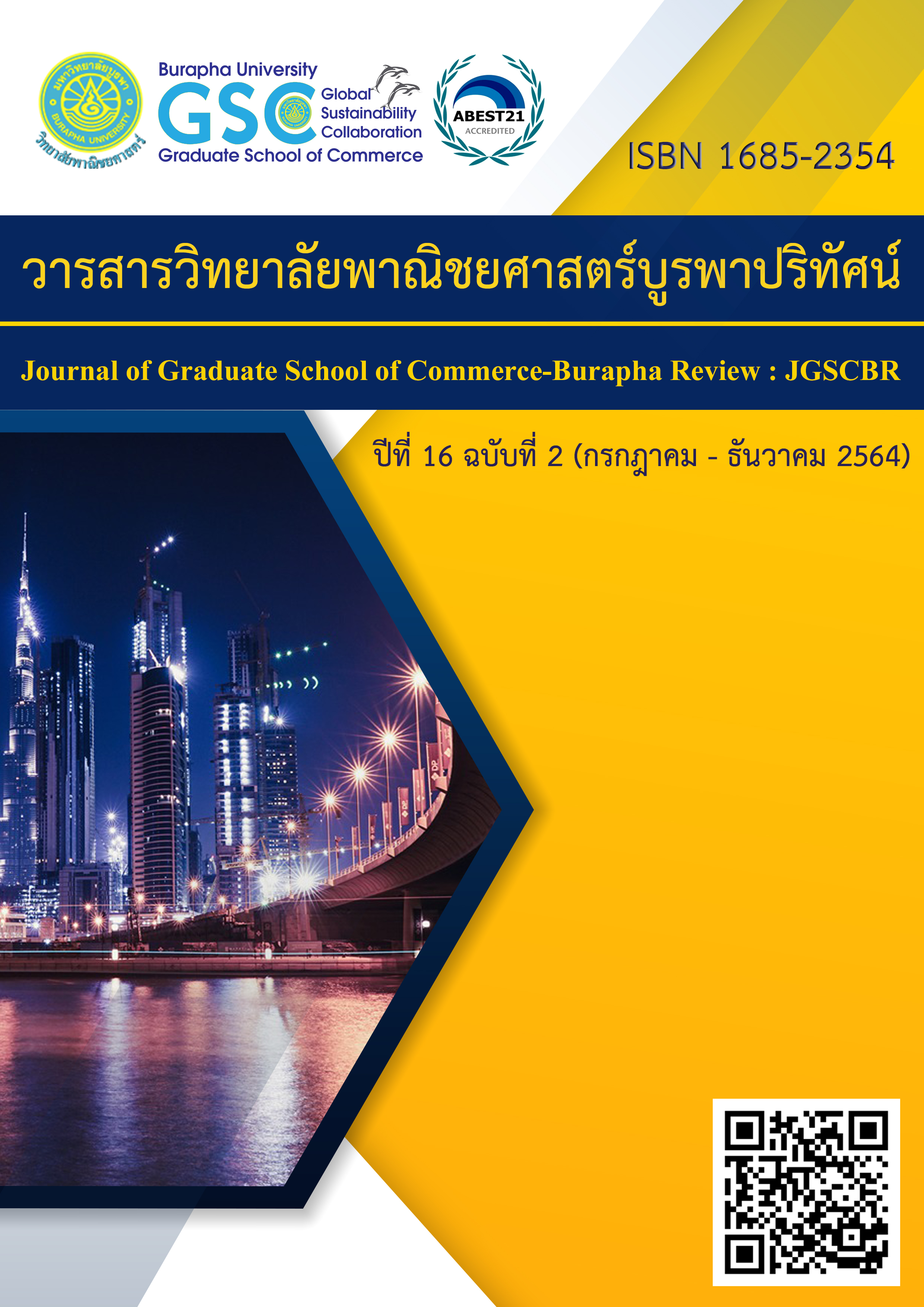THE PREPARATION OF THE INTERNAL AND EXTERNAL ENVIRONMENT FACTORS ON PRODUCTS AND SERVICES OF THE HOTEL IN HAT YAI DISTRICT, SONGKHLA PROVINCE TO WELCOME TOURISTS AFTER COVID-19 DISAPPEARANCE
Main Article Content
Abstract
The research had 3 objectives: 1) to study what tourists like and dislike when staying at hotels in Songkhla Province, 2) to compare the demand for the external and internal environment of tourists from private and government sectors, and 3) to compare whether the external or internal environment had more significant effect. The study was both qualitative research where 30 documents were synthesized and quantitative research where t-test, F-test and LSD were used. The total number of sample was 390 tourists from private sectors and government sectors.
The findings revealed that 1) the most favorable products’ external environment was the hotel’s nearness to the malls or the places to buy souvenirs. The most favorable service factor was the hotel was easy to find and the most unfavorable was the hotel was difficult to find. 2) To the hotel’s external environment, the guests from private sectors had greater demand for services than those from the government sectors. However, both groups had no differences in the demand for products. To the hotel’s internal environment, both groups had equal needs for products and services. 3) Products and services of internal environment were more significant than those of external environment.
Article Details
The owner of the article does not copy or violate any of its copyright. If any copyright infringement occurs or prosecution, in any case, the Editorial Board is not involved in all the rights to the owner of the article to be performed.
References
กฎกระทรวง. (2559). กฎกระทรวงกำหนดลักษณะอาคารประเภทอื่นที่ใช้ประกอบธุรกิจโรงแรม พ.ศ. 2559,ราชกิจจานุเบกษา, 19 สิงหาคม 2559, เล่ม 133 ตอนที่ 72 ก.
กรมพัฒนาธุรกิจการค้า. (2554). ธุรกิจโรงแรม. เข้าถึงได้จาก https://www.dbd.go.th/BisNov54.pdf
กรวรรณ งามวรธรรม และลลิตา นุ่มไทย. (2563). ถอดรหัสงานศิลป์ของศิลปินไทยเพื่อสร้างสรรค์สภาพแวดล้อมภายในโรงแรมบูติค. วารสารศิลปกรรมศาสตร์วิชาการวิจัย และงานสร้างสรรค์, 7(1), 149-170.
กระทรวงการท่องเที่ยวและกีฬา. (2558, 2559, 2560, 2561, 2562,). สถิตินักท่องเที่ยวภายในประเทศ Q1-Q4 ปี 2558-2562 (ภาคใต้). เข้าถึงได้จาก https://www.mots.go.th
กัลยา วานิชย์บัญชา. (2549). สถิติสำหรับงานวิจัย. กรุงเทพฯ: โรงพิมพ์จุฬาลงกรณ์มหาวิทยาลัย.
การท่องเที่ยวแห่งประเทศไทย. (2560). ข้อมูลท่องเที่ยวอำเภอหาดใหญ่ จังหวัดสงขลา. สงขลา: สำนักงานการท่องเที่ยวแห่งประเทศไทย.
จังหวัดสงขลา. (2560). สรุปข้อมูลจังหวัดสงขลา. สงขลา: สำนักงานจังหวัดสงขลา.
ชมพูนุช พูลทัศฐาน, ธีทัต ตรีศิริโชติ และบรรพต วิรุณราช. (2563). แนวทางการเตรียมความพร้อมเพื่อการพัฒนาศักยภาพนักศึกษาอาชีวะตามแนวชายแดนไปสู่การเป็นหัวหน้างานแรงงานต่างด้าวในภาคอุตสาหกรรมของประเทศไทย. เข้าถึงได้จาก https://so04.tci-thaijo.org/index.php/svittj/ article/download/241043/165749/
นิตยา พร้าวราม. (2558). แนวทางพัฒนาคุณภาพการบริการเพื่อรองรับนักท่องเที่ยวกลุ่มอาเซียน: กรณีศึกษา โรงแรมในอำเภอหาดใหญ่ จังหวัดสงขลา. วิทยานิพนธ์บริหารธุรกิจมหาบัณฑิต, สาขาวิชาการจัดการการท่องเที่ยว, บัณฑิตวิทยาลัย, มหาวิทยาลัยสงขลานครินทร์.
ประสิทธิ์ รัตนพันธ์. (2558). ปัจจัยที่มีผลต่อการตัดสินใจเข้ามาท่องเที่ยวในจังหวัดสงขลา. งานวิจัยทุนอุดหนุนการวิจัย. สงขลา: มหาวิทยาลัยหาดใหญ่.
ภัทร์มนต์ คงแจ่ม. (2558). ผลจากการใช้จ่ายของนักท่องเที่ยวที่พักโรงแรมบูติกต่อสภาพแวดล้อมทางธุรกิจของชุมชน: กรณีศึกษา บูติคโฮเทลในจังหวัดสงขลา. วิทยานิพนธ์บริหารธุรกิจมหาบัณฑิต, สาขาวิชาการจัดการการท่องเที่ยว, บัณฑิตวิทยาลัย, มหาวิทยาลัยสงขลานครินทร์.
รัตนะ บัวสนธ์. (2551). การวิจัยเชิงคุณภาพทางการศึกษา. กรุงเทพฯ: คำสมัย.
รุ่งอาทิตย์ บูชาอินทร์ และกฤษนัยน์ เจริญจิตร. (2563). การประยุกต์เทคโนโลยีภูมิสารสนเทศประเมินเขตศักยภาพทำเลที่เหมาะสมของธุรกิจโรงแรมบริเวณชายฝั่งทะเลตะวันออกของประเทศไทย. RMUTL. Eng. J., 5(1), 51-59.
วิทวัส รุ่งเรืองผล. (2561). เขาแบ่งประเภทโรงแรมกันอย่างไร. เข้าถึงได้จาก https://marketeeronline.co/ archives/68468.
ศิริพงศ์ รักใหม่, เยาวภรณ์ เลิศกุลทานนท์, กาญจนา แฮนนอน และกรกช มนตรีสุขศิริกุล. (2560).
การจัดการภาวะวิกฤตในธุรกิจโรงแรม Crisis Management in Hotel Business. วารสารวิทยาลัยดุสิตธานี, 11(1), 345-354.
ศูนย์วิจัยธนาคารออมสิน. (2563). ธุรกิจโรงแรม มิถุนายน 2563 Industry Update, หน่วยวิเคราะห์เศรษฐกิจภาคบริการ ส่วนเศรษฐกิจรายสาขา. เข้าถึงได้จาก https://www.gsbresearch.or.th/wp-content/uploads/2020/07/IN_hotel_6_63_detail.pdf
สำนักงานส่งเสริมวิสาหกิจขนาดกลางและขนาดย่อม (สสว.). (2553). บทวิเคราะห์ธุรกิจโรงแรมและ
รีสอร์ท ปี 2553: โครงการกิจกรรมเผยแพร่ผลวิเคราะห์ระบบเตือนภัยและระบบฐานข้อมูลแก่สาธารณะ, โครงการความร่วมมือระหว่าง สำนักงานส่งเสริมวิสาหกิจขนาดกลางและขนาดย่อม (สสว.) สำนักงานพัฒนาหน่วยบริการอุตสาหกรรม กรมส่งเสริมอุตสาหกรรม กระทรวงอุตสาหกรรม. กรุงเทพ: สมาคมส่งเสริมเทคโนโลยี (ไทย-ญี่ปุ่น).
Expedia. (2563). รายชื่อโรงแรมทั้งหมดในหาดใหญ่ จังหวัดสงขลา. เข้าถึงได้จากhttps://www.expedia.co.th/All-Hat-Yai-Hotels.d1440-p2.Travel-Guide-City-All-Hotels
Jia, W., & Zhifeng, W. (2020). Strengths, weaknesses, opportunities and threats (SWOT) analysis of China’s prevention and control strategy for the COVID-19 epidemic. Res Public Health 2020, 17(2235), 1-17.
Kotler, P., & Keller K. L. (2015). Marketing management (15th ed.). New Jersey: Pearson International.
Lewis, J. (2000). Are you being served?. Personnel Today, 2000(August), 28-29.
Rainey, H. G., Backoff, R. W., & Levine, C. N. (1976). Comparing public and private organizations. Public Administration Review, 1976(March-April), 56-57.
Steadmon, C. E., & Kasavana, M. L. (1988). Managing front office operations: The Education Institute of the American Hotel & Motel Association. Michigan: East Lansing
Wallace, S. S. (1958). Premises of Public Administration: Past and Emerging. Public Administration Review, 18(/), 102-105.
Wiley and American Society for Public Administration. (2015). Premises of public administration: Past and emerging. author(s). Retrieved from http://www.jstor.org/stable/973789.

